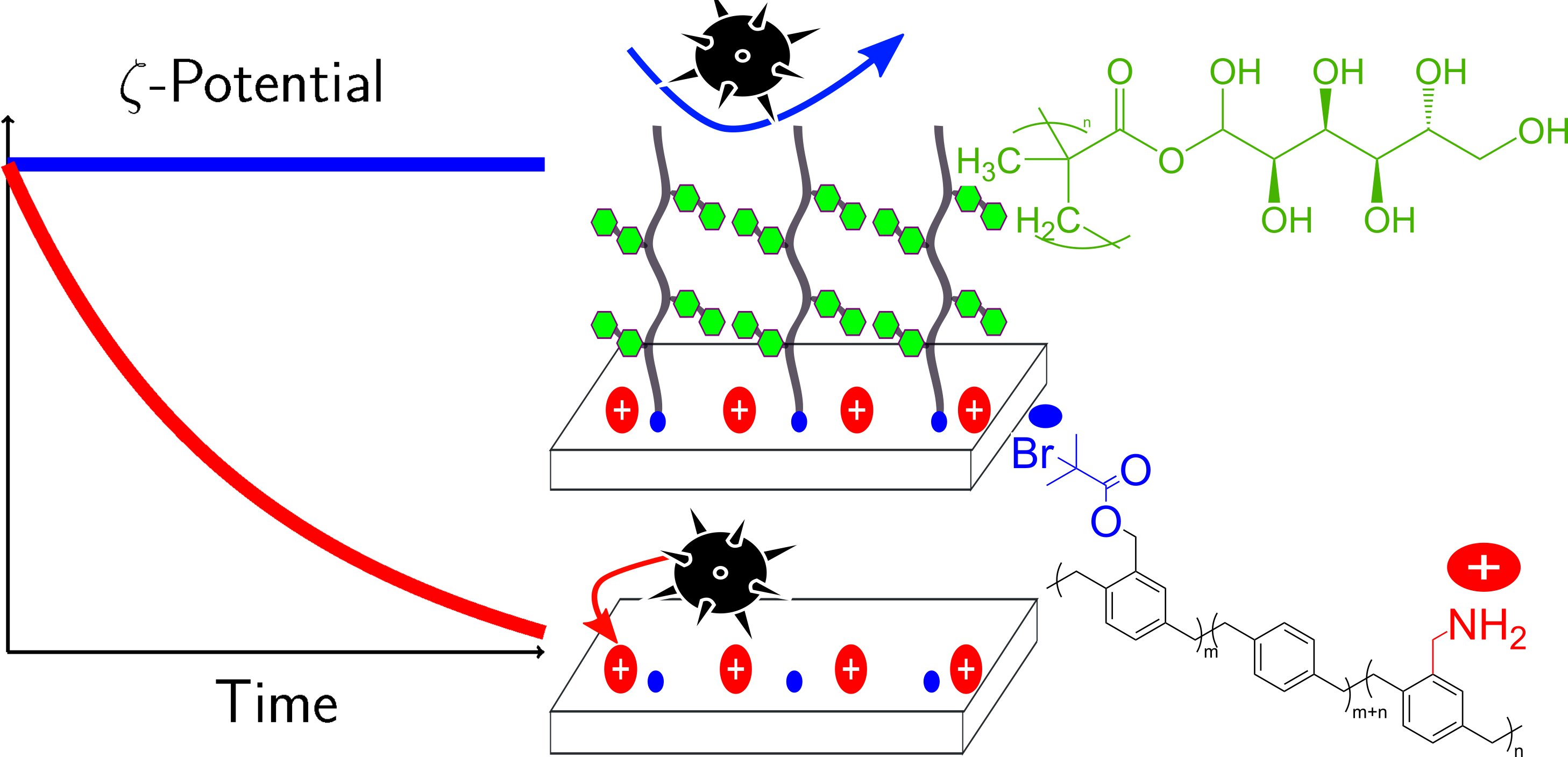Examining Interfacial Kinetics on Electrostatically Heterogeneous Surfaces using Zeta-potential Measurements.
Published in Langmuir, 2017
Recommended citation: Kumar,R., Kopyeva,I., Cheng,K.C., Liu,K. & Lahann,J. (2017) Langmuir, 33 (25), pp 6322-6332.
 Biomaterial surfaces can possess chemical, topographical, or electrostatic heterogeneity, which can profoundly influence their performance. By developing experimental models that reliably simulate this nanoscale heterogeneity, we can predict how heterogeneous surfaces are transformed by their interactions with the dynamic physiological environment. In this work, we present a model surface where well-defined glycopolymer brushes are interspersed with positively charged binding sites, giving rise to an interface presenting a mixture of repulsive and adhesive cues to an approaching virus particle. We show that the density of the affinity sites relative to the glycopolymer brushes can be tuned precisely by modifying the chemical vapor deposition (CVD) copolymerization conditions. Further, we examined the effects of binding site density and glycopolymer brush architecture on the adsorption kinetics of virus-like nanoparticles through a novel approach employing time-resolved ζ-potential measurements. Most materials have charge-bearing, dynamic surfaces that are sensitive to electrostatic effects. Hence, adsorption-triggered changes in ζ-potential measurements can be captured in real time to monitor interfacial events. Real-time ζ-potential measurements present an interesting platform to probe the structure and function of chemically and electrostatically heterogeneous polymer interfaces. To validate this electrokinetic method, we examined the effect of neutravidin concentration on its rate of binding to biotinylated surfaces using ζ-potential and compared our results with QCM studies. By applying electrokinetic methods to examine the roles of glycopolymer brush architecture and surface charge of these tunable glycopolymer coatings, we can enhance our understanding of the interactions of viruses with heterogeneous biomaterial interfaces.
Biomaterial surfaces can possess chemical, topographical, or electrostatic heterogeneity, which can profoundly influence their performance. By developing experimental models that reliably simulate this nanoscale heterogeneity, we can predict how heterogeneous surfaces are transformed by their interactions with the dynamic physiological environment. In this work, we present a model surface where well-defined glycopolymer brushes are interspersed with positively charged binding sites, giving rise to an interface presenting a mixture of repulsive and adhesive cues to an approaching virus particle. We show that the density of the affinity sites relative to the glycopolymer brushes can be tuned precisely by modifying the chemical vapor deposition (CVD) copolymerization conditions. Further, we examined the effects of binding site density and glycopolymer brush architecture on the adsorption kinetics of virus-like nanoparticles through a novel approach employing time-resolved ζ-potential measurements. Most materials have charge-bearing, dynamic surfaces that are sensitive to electrostatic effects. Hence, adsorption-triggered changes in ζ-potential measurements can be captured in real time to monitor interfacial events. Real-time ζ-potential measurements present an interesting platform to probe the structure and function of chemically and electrostatically heterogeneous polymer interfaces. To validate this electrokinetic method, we examined the effect of neutravidin concentration on its rate of binding to biotinylated surfaces using ζ-potential and compared our results with QCM studies. By applying electrokinetic methods to examine the roles of glycopolymer brush architecture and surface charge of these tunable glycopolymer coatings, we can enhance our understanding of the interactions of viruses with heterogeneous biomaterial interfaces.